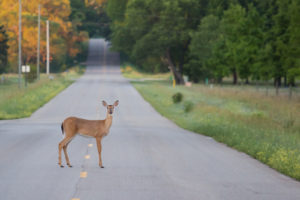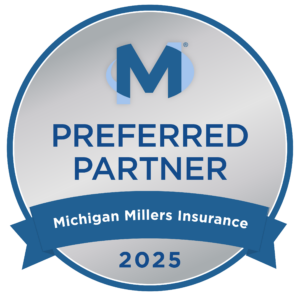Deer Collision Driving Program


Introduction
Deer mating season can be a dangerous time for drivers, deer and car hoods. According to the Insurance Information Institute, 1.6 million deer-vehicle collisions occur each year, resulting in 200 fatalities, tens of thousands of injuries and over $3.6 billion in vehicle damage. Being prepared can help prevent you from adding to these statistics.
When driving this Fall, you should:
1. HEED THE WARNING SIGNS: Collisions occur most often in prime deer habitat such as forested areas and waterways. If you see a deer crossing sign, be extra alert and slow down. Deer cross roads for a wide variety of reasons and at different times of the year. Often they want to get to another part of their habitat. Rutting season and hunting season also cause them to move. Stay alert.
2. DRIVE AT A SAFE SPEED: Do not speed when you are driving through deer country. You’ll still arrive if you go more slowly and you’ll have more time to avoid an animal if you spot it. Wildlife experts have recommended 55 mph as a suitable speed for wildlife zones in good weather conditions, as it provides you with some reaction time to stop. Here are the things that suffer when you travel to fast:
- You can’t stop quickly enough to avoid a collision.
- The impact of a car/truck is far greater the faster you travel.
- Your ability to take evasive action is massively reduced and you’re more likely to resort to swerving instead of braking and gently responding.
3. DRIVE DEFENSIVELY: Be prepared to take evasive action, which includes being able to quickly slow down, brake suddenly or turn down blinding headlights. Drive so that you are able to stop within the space of your headlights; practice this in a safe area if you don’t know how fast this is for your vehicle. Make sure your seat belt is on and check that all passengers are wearing theirs as well. A sudden lurch could have people catapulting from the car.
4. OBSERVE YOUR SURROUNDINGS: Actively scan the sides of the roads as you drive for any signs of wildlife. If you have passengers, get them involved but ask them not to shout out as this is very startling and can cause the driver to react incorrectly. Ask them to calmly tell you that they see deer lurking about. Look on the road sides, the shoulders, down into ditches (they love the grass there), median strips, intersecting roads, on the road itself and try to spot any signs of movement, flashes of eyes or body shapes.
- Watch both sides of the road; there is some evidence that drivers tend to watch the side of the road next to the passenger seat more than their own side, making a false assumption that only one side is a problem. Scan both sides!
5. BE ESPECIALLY WARY AT SUNSET AND SUNRISE: Deer seem to move most in the hours around sunset to midnight and again around dawn. These are also the hardest times for our eyes to adjust to the light because it’s neither completely dark nor properly light, so we find it more difficult to see well. If you don’t feel alert or can’t see properly at these times, save your trip for another time.
- Be on the lookout — if you see one deer, there are likely to be more deer nearby, even if you don’t see them. If you see one creature, it’s more likely that you’ll run into more.
6. DRIVE CAREFULLY AT NIGHT: Use your high beams where possible and when there are no oncoming cars that you can startle with them; they will illuminate more of the area that you are travelling through. Here are some other precautions to take when you’re driving in the dark:
- Move into the center lane if you are travelling in a 3 lane road, or center the car as much as possible if it is a 2 lane road.
- Make sure your windshield is clear and is not reflecting grime, preventing you from seeing clearly.
- Drive below the speed limit, which has fuel economy benefits as well as safety benefits.
- Scan the sides of the road for animals’ reflective eyes, often visible at a great distance at night. Sometimes this is the only visible part of the animal until it is directly in your path.
7. SLOW DOWN WHEN OTHER CARS ARE BEHAVING DIFFERENTLY: If you see flashing lights (hazard or headlights), hear tooting horns or see people waving madly about, slow down and be ready to stop! Of course, if a car stops suddenly ahead of you, you should also stop or at least slow right down. In these situations, the other cars may well have stopped because animals are already crossing the road ahead of you.
8. BE ALERT — EVEN WHEN YOU’RE APPROACHING A TOWN OR A CITY: You’ve just driven into the outskirts of town, so everything is safe now, right? Wrong! Deer wander into towns and city outskirts in search of food. They could be munching away on the median strip or bolting from someone’s front garden. Still drive carefully. When you do come across a deer, don’t expect them to react rationally.
- Blasting horns, flashing lights and a swerving metal machine are likely to terrify the animal witless and it will more than likely dart into your way rather than out of it. Bucks have been known to charge a stopped or moving car of any size.
9. KNOW WHEN NOT TO SWERVE: If you suddenly have a deer before your car, brake firmly. Do not swerve and leave your lane; many accidents are not due to colliding with the deer but are the result of driving into another car or truck in the opposite lane while trying to avoid the animal. The best thing to do is drive defensively in the first place and go slowly enough that you won’t collide with a deer and can brake in time.
10. HONK YOUR HORN AT THE DEER IN SHORT BURSTS: Only do this if the deer is far enough ahead and there are no cars around that can be disoriented by the honking. This may scare the deer away, but there’s no guarantee that it will make the deer run off the road. If you’re quite close to the deer, you may want to avoid honking at it, because the deer may get confused and come closer to you.
What to Do During a Collision
1. DIMINISH THE IMPACT IF IT IS INEVITABLE: If an accident with a deer is inevitable, here are some suggestions for lessening the impact:
- Try to move to where the animal came from. This may take you away from it and the animal is more likely to keep moving forward rather than backtracking. This will only work if there is one animal. This will not work for more than one deer.
- Shift your line of eyesight to that spot as well – don’t look at the animal or you’ll steer that way.
- Try to skim rather than fully impact the animal. Brake firmly, angle the car/truck and take your foot off the brake as you impact. The release of the brake will cause slight lift of the vehicle and this may be enough to stop the animal from rising into your windshield if your vehicle is tall enough.
- If you’re heading into a collision with a deer, lean toward the door pillar. In the Mythbusters where they tested this, the center of the car was completely crushed in every impact but the triangle by the door pillar was intact in each accident. No guarantees are offered; you are far better off avoiding the collision.
2. TAKE CARE AFTER A COLLISION WITH A DEER: There are some important steps to take after assessing if everyone is relatively unharmed:
- Pull over if possible. Put your hazard lights on and if you can, put the headlights onto the animal or as close as possible.
- Check passengers for injuries and treat accordingly. Even if there are no injuries, shock will probably occur fairly quickly. Try to reassure one another and if it is cold, put on warmer clothing immediately as shock or fear increases the inability to ward off cold. If it is winter, stay in the car for warmth.
- Avoid going near the animal; it may kick or gore you from fear and pain. If it blocks the road, use your hazard lights and headlights and keep your car stationary. Only attempt to move the animal if you are 100% certain that it is dead.
- Use road flares or triangles if you have them.
- Call the police immediately or flag down help. When contacting the authorities, let them know if the deer is in a dangerous spot on the road so that it can be removed.
- Remember that most insurance companies won’t pay for the damages you suffer from hitting a deer if you don’t file a police report.
Tips
- Watch for water intersecting with the road – creeks, swamps, and wetlands are deer attractants. The road is an easy pathway out of these waterways for an animal, so there is a higher possibility that they may be around them.
- One deer means more deer. Deer travel in herds and if you see one, slow right down as there will be many more.
- Use the headlights of other cars to help you scan for deer. Watch for moving shadows within the beams of the other cars for signs of deer.
- Be extra aware if there is a fire. Deer and other animals will move quite a distance away from the fire and will cross roads far from their usual areas. Even if the fire is miles away, watch for the animals at any time to be leaving the fire areas.
- Think ahead about how you would personally react in the situation of a deer appearing before you. This pre-preparation mentally can make your reactions better and calmer.
- Sometimes deer will freeze in car lights as you approach even if they are not directly in the roadway and then suddenly bolt into the roadway as you drive close by them. In some instances this will result in the deer hitting the side of the car. This is tough behavior to encounter as slowing down could result in the deer being even more likely to hit your car.
- Another option is to quickly accelerate to get past the animal. It is difficult to choose this option fast enough to be effective because accelerating feels very counter-intuitive at this point. However, in the right circumstance, it can be your best option to avoid a collision.
- Get a motel room, pull over and rest or stay where you are and leave later if you feel that driving around deer is too dangerous. It is better to arrive alive and late than to be injured or killed in the name of punctuality.
- The best advice for this may be to keep driving at the speed you are going without any rapid change in speed or direction and let the deer’s natural instincts take care of both of you. It obviously helps to moderate speed in circumstances where this might happen.
- Deer are crossing the road a lot during fall because of hunting season and rutting season. Always be careful.
Warnings
- Fences along the roads are not an assurance of safety. Deer can walk around them, through them or over them. Don’t rely on them; for peace of mind, drive carefully instead.
- Don’t switch on the vehicle’s internal lights. This causes glare on the inside of the windshield which could reduce visibility and make the animals harder to see.
- If you swerve away from a deer in the road and hit something else, like a safety rail or tree, your automobile insurance may charge you for an at-fault accident and make you pay your collision deductible. If you hit the animal you will pay your comprehensive deductible, which is often lower than your collision deductible.
- Deer whistles are somewhat of a gimmick; do not expect them to work.
- Do not drive if you are sleepy or you have had alcohol. Being sober is not only a prerequisite for driving safely, it is also essential for avoiding collisions with animals.
- Deer have wounded or even killed a person to protect her calves. Even if you mean no harm to the calves the deer will not perceive it that way.
- These tips will NOT work on other hoofed quadrupeds such as horses or reindeer and can only be used safely on deer.
More Insight & Tips
The latest company news and industry insight from Lawley.








